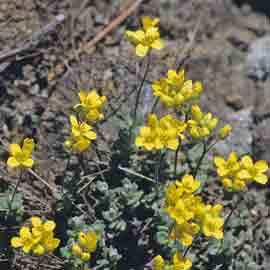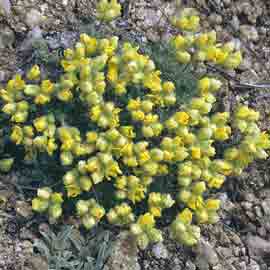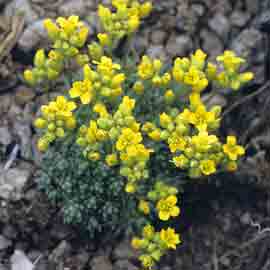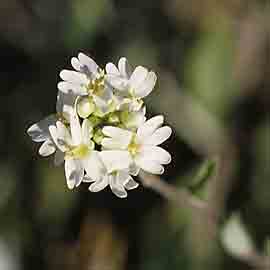Home | Next |
Previous | Index |
Purchase book
Idaho Mountain Wildflowers
Mustard, or Cabbage Family: Brassicaceae
The scientific family name Brassicaceae is derived from the Latin
brassica, a word that means “cabbage.” (An older family
name, Cruciferae, is still in use although most botanists prefer the former
name.) The family contains many valuable food plants rich in vitamin
C and sulfur compounds—the latter are responsible for the typical smell
and taste of foods such as cabbage, brussel sprouts, broccoli, turnip, and
mustard (all of which belong to the genus Brassica ), water cress
(Rorippa spp.), radishes (Raphanus spp.), and many others.
While these are of great economic importance, the family also contributes
ornamentals to our gardens: ornamental cabbages, wall-flowers
(Erysimum spp.), rockcresses (Arabis spp.), and others. The
flowers’ four petals usually form a cross, explaining the older family
name Cruciferae, derived from the Latin crus (cross) and fero
(I bear) and members of the family are often referred to as
“crucifers.” The flowers are frequently borne in clusters
(“racemes”). Leaves are usually simple, alternate, and lack a petiole
(a leaf stem). Most of the Brassicaceae form seedpods. When these are long,
they are “siliques”; when short, they are known as
“silicles.” The leaves and other parts of the plants often have
a radishy taste. Members are represented in our mountains by several genera
and many species, including some with showy flowers, as shown on the following
pages. Most likely any small, four-petaled, early spring-blooming wildflower
will belong to the mustard family.
 |
Draba species: The drabas are the largest genus in the mustard
family with about 350 species. The name, from Greek antiquity, was used for
a now unknown crucifer. “Whitlow grass” is an old English
name for drabas because they were used as poultices to treat
“whitlows,” or “run-arounds”—infections at the base
of the nails. At lower altitudes drabas tend to be long-stemmed solitary
plants with small white, pink, or yellow flowers. At higher elevations,
they form compact clumps on rocky slopes, usually flowering at the end of
snowmelt. . Some are localized to one area or mountain range. These plants
are so alike that species identification is difficult.
Few-seeded draba, Draba
oligosperma
Hook. (left). The species name, oligosperma, means
“few seeds.” The few-seeded draba grows in all but the most southern
of our western mountain states and in Canadian provinces, from lower elevations
to subalpine slopes. While its flowers are similar to other plants shown
on this page, its narrow leaves do not form mats.
Payson’s draba, Draba paysonii J.
F Macbr. (right). Payson’s draba is found only
at high elevations in the Sierras, and northern Rocky Mountains in the United
States and Canada. The plant shown here was photographed well above treeline
on Mount Borah, Idaho’s highest mountain. Its tiny, hairy, clustered
leaves grow at ground level and remain well hidden when the plants are in
flower. Two varieties are recognized; ours is var. treleasii (O. E.
Schulz) C. L. Hitchc. |
 |
 |
Stanley Creek draba, Draba trichocarpa
Rollins. (left) The Stanley Creek draba has the
most restricted range of any of the very similar alpine/subalpine plants
shown on this page, for it is found only near Stanley, Idaho. Because this
species was described relatively recently it is often not listed in regional
plant guides. Its four-petaled flowers are small and remain partially closed,
and its tiny leaves form tight clusters. The species name, trichocarpa, means
“hairy fruit.”
Globe-fruited draba, Draba
sphaerocarpa J.
F. Macbr. & Payson. (right). This cushion-forming
plant,grows only on exposed alpine and subalpine ridges of the Sawtooth
Mountains. Its common and species names both refer to its rounded fruit.
While many draba species are quite similar, tentative identification is sometimes
possible based on plant location and appearance. Definitive identification
usually depends on technical differences among the fruits of various
species. |
 |
 |
Lance-leaf draba, Draba cana
Rydb. (left). The lance-leaf draba (also known as the
cushion whitlow-grass) blooms later in the spring than do those shown above,
favoring high open slopes and rocky crevices. This plant’s classification
has been a source of confusion in the past. It has variously been classified
as Draba lanceolata or as Draba breweri. The classification
used here is correct. The plant is found throughout the Rocky Mountains to
Alaska, east across the continent to several northern states, and south to
California, Nevada, New Mexico, and Utah. It also grows in Greenland and
Eurasia.
Spring whitlow-grass, Draba
verna L. (right).The spring
whitlow-grass is an imported European weed that has spread throughout much
of the Northern Hemisphere. It is found throughout Idaho. It is easily identified
by clustered bright-white flowers. The flowers are unusual for they have
two pairs of opposed, deeply cleft petals—a feature that serves to identify
the plant |
 |
Home | Next |
Previous | Index |
Purchase book





